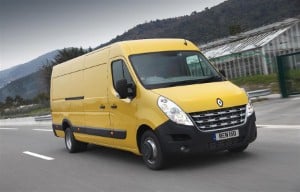Renault announces improvements to Master van range
20/08/2012 17:47
Share

Renault announces improvements to Master van range
Renault has announced it is making a raft of its improvements to its Master van range to provide drivers of the commercial vehicles with better fuel efficiency and more features.
With the launch of new Master in 2010, Renault introduced an M9T engine developed especially for the model, with the 2.3 dCi powerplant coming in a choice of three power outputs: 100hp, 125hp and 150hp.
The new enhancements mean its fuel consumption has been improved by up to 3.8 mpg for the SL/SM dCi 125 Quickshift6 Euro 5 versions, while the core-selling dCi 125 was up by 3.3 mpg (SL/SM versions).
CO2 emissions also now start at 194 g/km, and are down by an average of 16g/km, and 24 g/km in the case of dCi 125 Quickshift6 Euro 5 versions of SL28 and SL33.
According to Renault's engineers, these savings have been achieved by focusing on the key areas of thermal management, with an improved water circuit for even faster starting, as well as the development of new oil and power steering pumps, low fuel-consumption tyres and a new gearbox lubricant.
In addition, Renault has enhanced cabin comfort by offering a selection of new, easier to use and better-equipped radio.
Furthermore, Bluetooth and USB connectivity are now standard features across the range, while the flagship Sport versions come with a CD player and MP3 playback, as well as a separate display.
Another key feature is optional air suspension, which is also now available for the vast majority of the front-wheel drive range, including panel vans, Chassis Cab, Chassis Double Cab and Platform Cab, irrespective of engine.
The benefits of this, according to the manufacturer, are the maintenance of a constant ride-height irrespective of load and correct differences behind the left- and right-hand sides of the vehicle.
It also permits the vehicle's ground clearance or rear clearance angle to be raised momentarily, and allows for the rear suspension to be dropped to achieve a lower rear sill height and drivers can manually adjust the deck height at the rear by +70mm or -60mm.
Posted by Sebastien Turkenburg